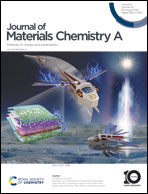Ultrahigh photoresponse in strain- and domain-engineered large-scale MoS2 monolayer films†
Abstract
Strain engineering has been recognized as a critical strategy for controlling electrical and optoelectronic properties, even in atomically thick two-dimensional (2D) transition metal dichalcogenides. Herein, the combined effects of strain engineering and domain engineering are explored in unconventional centimeter-scale monolayer MoS2 films to generate ultrahigh photoresponses. Two-step strain engineering for maximizing the built-in tensile strain favorably reduced the optical bandgap of monolayer MoS2 and the potential barriers at junctions, resulting in record performance. Directional adjustments of the domains with respect to their atomic arrangement in the planar epitaxial structure of MoS2 also contributed to the extraordinary photodetection behavior. As a performance highlight, an impressive photocurrent of 22.9 μA and photoresponsivity of 1142 A W−1 at an incident power density of 9 × 10−4 mW cm−2 were achieved in the case of a total tensile strain of +1.80% and domain adjustment with zigzag-edge atomic arrays, which are the highest values reported thus far for 2D visible photodetectors. The origin of these enhancements is systematically examined with experimental evidence, including changes in the energy bandgap and estimated potential barriers associated with band alignments and an additional polarization field.

- This article is part of the themed collection: #MyFirstJMCA


 Please wait while we load your content...
Please wait while we load your content...